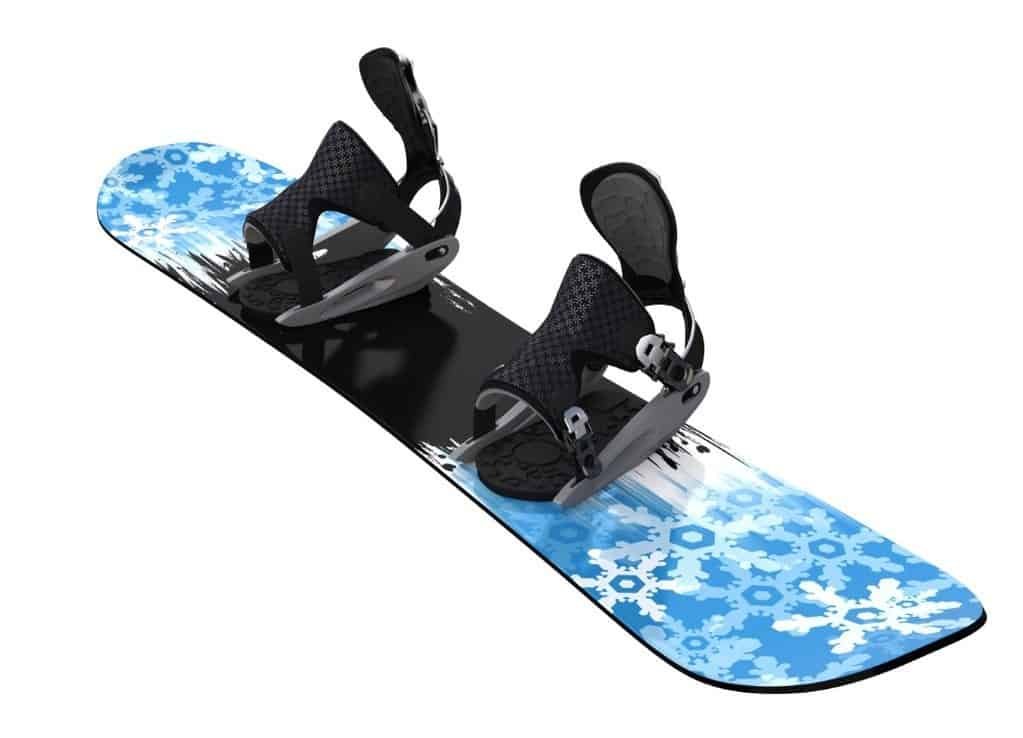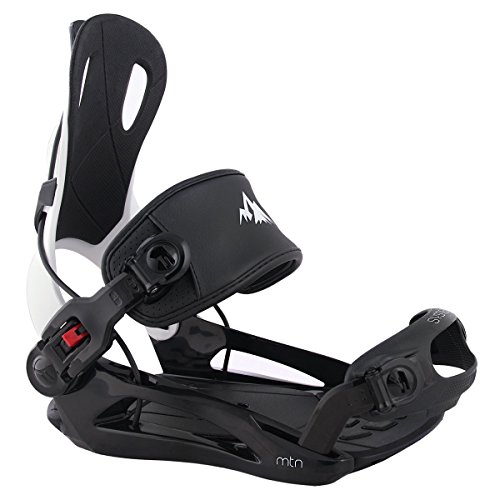What are the best snowboard bindings for beginners? The Salomon Rhythm Snowboard Bindings are my personal favorites.
Last update on 2025-07-12 / Affiliate links / Images from Amazon Product Advertising API
After you select the snowboard to purchase, the next thing that you need is your bindings.
The bindings are a very crucial part of your snowboarding gear because they are the point of attachment of your feet to your selected snowboard. The ones you choose will also affect how you ride.
Not all products are alike, and the best beginner snowboard bindings are those which can support your selected style of snowboarding from the very start.
Reviews of the Best Snowboard Bindings for Beginners
1. Salomon Rhythm Snowboard Bindings
The Salomon Rhythm Snowboard Bindings are designed to offer a great overall performance.
The emphasis in the construction is comfort as well as stability and resilience. Therefore, beginners, intermediate snowboarders, and even borderline experts will find these products to be perfect for a well-rounded experience on the snow.
These bindings are best for those who are beginners, and still learning and practicing snowboarding. The padding on the ankle straps and the EVA sole padding make it very comfortable so that beginners who practice all day can still feel comfortable at the end of the day.
What is particularly great about these bindings is the universal disc that enables them to be used with any snowboard available today.
Pros:
- The toe straps are located on the top part of the toes, which locks in the toes of your boots rather than just cupping it. This kind of strap is more reliable than simply having a full cap strap because it provides more control over the board.
- Padded ankle straps enable seamless contact of your boot with the bindings whether you prefer a tight or a loose fit
- The HB vibration filter is something that you will only find on Salomon bindings and it helps absorb shock, which comes very useful when landing after doing tricks or when used on bumpy terrain. Additional shock absorption is provided by the EVA sole padding
- The Rhythm high back is very lightweight and flexible thanks to the core-out design. The soft flexibility that it provides enables easier steering.
- The universal disc ensures that you can use it with any snowboard, which is great if you are still trying out boards and are still unsure about the one you want to purchase.
Cons:
- The high back is a bit lower than other bindings, and although it is made to feel more flexible, it can also make you feel that you are not tightly secured. However, there is still enough support and tightness guaranteed.
2. System MTN Rear Entry Snowboard Bindings Review
As you will see, these bindings are nothing short of spectacular. The truly great thing about these ones is that they work exceptionally well for people of all skill levels; it doesn’t matter if you are a novice or a skilled snowboarder, you can use these bindings with the same level of comfort.
The System MTN Rear Entry Snowboard Bindings have a rear-entry design that makes it easier and faster to put on. These have ample cushioning at the toes, heels and ankle strap that lessens the shock.
The response back feature of this binding makes it a very responsive one, which makes it possible to be used on relaxed rides while you are simply cruising through an easy course, or through more difficult and steep, or even backcountry rides.
Pros:
- The rear entry design of this snowboard binding makes it quicker to wear and it is even possible to secure the boot in place while in a standing position.
- This is a well-cushioned binding with pads on the toe ramp, heel, and high back. The cushioning lessens the shock and chatter for a smoother ride, which is greatly appreciated when riding on routes with icy snow.
- The high back has a response back feature, which tightens the cable pull mechanisms as you push harder on it. This just means that on slower or flatter terrain, you will have a more relaxed fit, and when the terrain changes and you put pressure on the high back, it will tighten to provide you with more control.
- The multidisc base plate makes sure that the bindings can be securely mounted on all snowboards such as those that have the standard four-hole or even the Burton three-hole.
- It can also be adjusted to fit your riding style with the forward-lead adjustment as well as the sliding strap adjustments
Cons:
- It is available in two sizes but the XL size can only accommodate up to a size 12, so men with larger feet won’t be able to use them
View on Amazon
3. K2 Cinch TS Snowboard Bindings
No products found.
The popularity of K2 snowboarding products can be attributed to the consistent quality that the company delivers. Therefore, if you are looking for reliable snowboard bindings, you should consider the K2 Cinch TS.
These are highly rated products that present great advantages for both novices in the sports and even advanced enthusiasts.
The K2 brand is reliable and therefore, a suitable choice for snowboarders who have not had the opportunity to experiment with alternatives.
These bindings have all-round benefits for all users; they are comfortable, safe and promote better control.
While they might be a little bit heavy, this is not a significant limitation for most snowboarding novices or experts.
Pros:
- Comfortable highback design which padded and asymmetrical for a natural stance.
- The cinch strap system is secure and easy to use.
- The bindings are highly durable and resistant to mechanical damage and tears.
- Medium rigidity promotes both comfort and control on the snow.
Cons:
- K2 snowboard bindings are slightly heavy, but not too noticeable. It is still a worthy option.
No products found.
4. Flux PR Snowboard Bindings
When looking for new snowboard bindings, you must evaluate and compare multiple products before purchase.
My choice to consider is the Flux PR Snowboard Bindings. These are designed to provide optimal support and performance for people of diverse skill levels.
Both experts and beginners can use these without experiencing much strain or restriction.
It lets riders feel that their boot is really secure in place. It may be used with aggressive boards because it can handle what is thrown at it, although improvements on the cushioning with future models would be a great improvement.
The current model doesn’t have much cushioning to effectively absorb the shock brought by an all-mountain or backcountry terrain.
Pros:
- The Ultima Wing high back is shaped differently than other bindings to add more outside support. This helps provide better control while leaning towards the nose or the tail of the snowboard.
- All adjustments, except for attaching it to the board, can be done without making use of any tools. This makes adjustments easy, fast and more convenient.
- This binding is highly responsive, which is why turning is fast. This makes it a perfect partner for a more aggressive board, although it can also be used on snowboards meant for beginners.
- The heel and the ankle strap conform to the shape of the boot; it is capable of providing a good fitting, which is comforting especially for beginners who fear that their foot can fall out of the bindings during their ride.
Cons:
- Although the lack of pads on the heel enables it to fit well on the boot, there is an overall lack of padding.
5. Union Flite Pro Snowboard Bindings
When it comes to finding the best snowboard bindings, the sheer number of products available can be overwhelming, making the entire buying experience much more complicated than it needs to be.
Fortunately, there are products like the Union Flite Pro Snowboard Bindings. If you really want a solid product that has proven itself time and again, this is definitely one that you should not miss out on.
These bindings are designed to be very lightweight so they can perform well when used with freestyle riding.
They can also be used in all-mountain terrain by beginners and experts alike. It is a rear-entry binding that has adequate cushioning on the footbed to absorb shock brought about by riding on various terrains, or by landing from a jump or a trick.
Pros:
- This binding can be used for all-mountain freestyle, which includes various mountain terrains and even snow parks.
- It has a broad range of compatible boards such as those that make use of 4 holes and ICS channel systems.
- The lightweight high back is cored out to make sure it is very light, but is still very responsive to turns, so that shredding all over the mountain is more enjoyable.
- The Flite baseplate is also very lightweight and it has medium flexibility, which enables freestyle riders to be in control.
- Anodized aluminum is also used for the heel cup to provide stiffness and strength while still being very lightweight.
- The base is padded adequately to absorb shock, which is very handy on landings with freestyle riding.
Cons:
- The toe strap has a tendency to be stick on the boots, which is why it can be more difficult to remove. Just need to wiggle it a little.
View on Amazon
How to Choose the Best Snowboard Bindings
Choosing a snowboard binding is similar to choosing your snowboard.
You have to consider how you are going to use it, and what type of rider you are. In this way, you get to fully enjoy the features of your gear.
If you are looking into purchasing your snowboard bindings, you have to take note of several things, such as those found below.
Your riding style
The type of binding that you purchase should be able to support you and help you to easily perform well with the riding style of your choice.
There are bindings that are specifically designed for different riding styles but there are others that are designed to work with any riding style.
These last ones are mostly chosen by beginners who are still getting to know the basics and are just enjoying learning how to ride. They do what they are meant to do, which is to keep your boot attached to your board, but they do not have any special features inclined to help you improve your performance.
Compatibility with your snowboard
Choosing a snowboard and snowboard bindings goes hand in hand. If the binding is not compatible with your chosen board, then it won’t be able to let you enjoy the winter sport.
Bindings that are not necessarily compatible with your snowboard may still be attached to it, but they won’t be secure nor would they feel comfortable. It can also be difficult to control your board when the bindings are not compatible.
There are different kinds of hole patterns on snowboards, but most of them are compatible with each other. If you buy a binding that isn’t compatible with your snowboard, you can buy universal discs that will serve as adapters so that the two can fit.
When the bindings are compatible with the board, they will fit snugly and it can comfortably accommodate your boots. Aside from compatibility with the snowboard, you should also make sure the binding is compatible with your boots and your foot size.
Flexibility
The flexibility of your binding is also an important factor in choosing your bindings.
Most beginners and those who love freestyle snowboarding prefer to have softer flexibility. These are more forgiving, and they are better at landings from jumps or tricks that freestyle snowboarders do in snow parks.
On the other hand, stiffer bindings are more preferred by more advanced riders who love speed and riding on steeper terrain. Stiffer flexibility will provide better control of the board especially during high speeds.
Boot support and padding
Cushioning on the base of the binding, as well as the straps can help with shock absorption. This helps provide a smoother ride and is very useful when you enjoy jumps or more challenging terrains.
If you do tricks or jumps, the impact would be lessened with adequate cushioning. This can help lessen the strain or impact that your joints receive while snowboarding.
Quality of materials
The materials used to create the bindings should also be considered in your selection because the materials can affect the weight of the bindings as well as its stiffness.
Aluminum-base plates are great because they are lightweight, but they are less responsive than other baseplates that are made of composite materials.
Stiffer bindings can be made by adding glass-reinforced nylon on the baseplate and this can result in a more responsive binding.
Types of Snowboard Bindings
There are two main types of snowboard bindings available on the market today.
Strap Bindings
The first and most common of the two are strap bindings.
This type of binding makes use of straps that are adjustable by ratchets or buckles to secure your boot in place.
The straps are found across the ankle and one above or across the toes.
To strap this in, snowboarders are most likely to sit down while doing it.
Most high backs on this kind of binding don’t move at all, although there are some that may allow adjustments for the forward lean.
Speed-Entry Bindings
The other type of snowboard binding is the speed-entry binding.
These may look similar to the strap bindings but they have a major difference and that is the high back.
In this type of binding, the high back serves as the entry point and it can be opened fully so that you can fit your boot in the bindings.
This type of binding is well-loved because you can wear it and get ready for your ride much faster as compared to the strap binding.
Although some people may still sit down when securing their boot in this type of binding, many can do it while standing up.
With or without high backs?
There are some snowboarders who claim that riding without high backs is better because it is less controlling of your movements. The ankles are freer, which could help in boosting jumps or flexing the ankles as you land.
Although some snowboarders prefer riding with no high backs, most, if not all of the bindings manufactured today still have high backs because the ankles would be exposed and are not protected.
There are different views on riding with or without a high back. Many snowboarders ride without a high back just to experience it. It is a personal choice, but for beginners and for safety’s sake, having high backs would be a better choice.
My Choice for the Best Beginner Snowboard Bindings
All bindings mentioned in this review are compatible with most snowboards, but for me, the Salomon Rhythm Snowboard Bindings are the best choice for beginners and more advanced snowboarders alike.
They are lightweight and have adequate cushioning that absorbs shock.
Beginners will appreciate how easy it is to turn, and freestylers will love the control they get out of it.
They also have the Exofit Power Strap that covers the midfoot to connect the toe strap and ankle strap for more control and a more comfortable riding experience.
Top Rated Snowboard Bindings
Last update on 2025-07-02 / Affiliate links / Images from Amazon Product Advertising API










